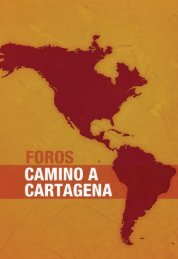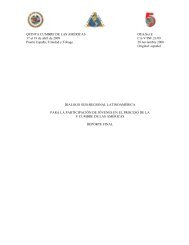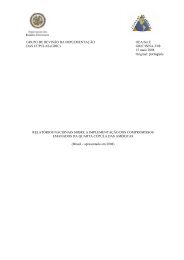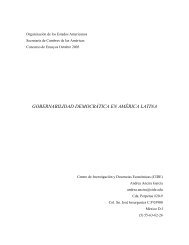The Road to Hemispheric Cooperation: Beyond the Cartagena
The Road to Hemispheric Cooperation: Beyond the Cartagena
The Road to Hemispheric Cooperation: Beyond the Cartagena
You also want an ePaper? Increase the reach of your titles
YUMPU automatically turns print PDFs into web optimized ePapers that Google loves.
$350 billion in 2010, with China displacing Japan as <strong>the</strong><br />
main trading partner with LAC. 10 For some countries in Latin<br />
America, <strong>the</strong> Asia Pacific region represents a massive market:<br />
nearly 45 percent of Chile’s exports go <strong>to</strong> that region;<br />
<strong>the</strong> figures for Peru and Brazil are about 25 percent each.<br />
Chile and Peru have signed a combined 11 PTAs <strong>to</strong> date<br />
with countries in <strong>the</strong> Asia-Pacific region. <strong>The</strong> increased importance<br />
of trade with Asian partners allowed <strong>the</strong>se countries<br />
<strong>to</strong> wea<strong>the</strong>r <strong>the</strong> global financial crisis relatively smoothly,<br />
whereas those sub-regions with closer trade ties <strong>to</strong> <strong>the</strong><br />
U.S. (namely Mexico and <strong>the</strong> CACM countries) suffered a<br />
sharp downturn.<br />
future Scenarios<br />
<strong>The</strong>re are several new pathways for <strong>the</strong> future of trade integration<br />
in <strong>the</strong> Americas <strong>to</strong> take: promote multilateralism, streng<strong>the</strong>n<br />
regional blocks and explore regional convergence.<br />
Multilateralism<br />
In an increasingly integrated world, multilateral trade liberalization<br />
matters more than ever. One of <strong>the</strong> key benefits<br />
of multilateral trade negotiations is that <strong>the</strong> principle<br />
of “most-favored-nation” (MFN) applies, such that any<br />
trade preference extended <strong>to</strong> one WTO member must be<br />
offered <strong>to</strong> all. Under a successful conclusion of multilateral<br />
liberalization, firms everywhere could bypass overlapping<br />
preferential agreements and rules of origin requirements.<br />
Multilateral negotiations would be optimal and should<br />
remain a priority. At <strong>the</strong> same time, <strong>the</strong> new concept of<br />
“multilateralizing PTAs” has emerged as a means <strong>to</strong> enhance<br />
compatibilities between PTAs and <strong>the</strong> global trading<br />
system, and <strong>to</strong> strive <strong>to</strong> advance <strong>to</strong>ward global free trade<br />
by way of PTAs.<br />
Sub-regionalism<br />
By deepening sub-regional integration initiatives (such as<br />
Mercosur, NAFTA, CAFTA, CACM, CARICOM, etc.), Latin<br />
American countries can consolidate regional trade preferences<br />
and move <strong>to</strong>ward building deeper common markets.<br />
CAFTA provided a pragmatic alternative for convergence<br />
of disciplines and multiplicity of rules of origin, by cumulating<br />
rules of origin requirements in some textile categories.<br />
In <strong>the</strong> case of Mercosur, consolidation in<strong>to</strong> a cus<strong>to</strong>ms<br />
union as a bloc—including macroeconomic convergence<br />
and <strong>the</strong> dismantling of exceptions in common external tariff<br />
(CET) and duties—would provide <strong>the</strong> political commitment<br />
necessary <strong>to</strong> advance <strong>the</strong> Mercosur process. Mercosur<br />
is <strong>the</strong> second largest cus<strong>to</strong>ms union outside of <strong>the</strong><br />
EU and epi<strong>to</strong>mized <strong>the</strong> “new regionalism” in <strong>the</strong> 1990s,<br />
which was based on “open regionalism” and shared development<br />
goals. <strong>The</strong> Pacific Alliance is <strong>the</strong> most recent and<br />
pragmatic response <strong>to</strong> new challenges at <strong>the</strong> sub-regional<br />
level, with a strategic focus on positioning <strong>the</strong> region <strong>to</strong>ward<br />
<strong>the</strong> emerging Asian markets.<br />
However, <strong>the</strong>re are still challenges. For example, after <strong>the</strong><br />
Mercosur cus<strong>to</strong>ms union agreement was signed in Ouro<br />
Pre<strong>to</strong> in 1994, <strong>the</strong>re have been persistent tariff exceptions<br />
for both intra-zone zero tariffs and common external<br />
tariffs. Two of <strong>the</strong> founding members of <strong>the</strong> Andean Community<br />
(CAN)—Chile and Venezuela—left <strong>the</strong> grouping in<br />
1975 and 2006, respectively, because of disagreements<br />
over trade and o<strong>the</strong>r issues. Recently, <strong>the</strong> four remaining<br />
full members have adopted somewhat divergent positions<br />
over trade policy. <strong>The</strong>re are also inadequacies that need <strong>to</strong><br />
be addressed in regional dispute settlement mechanisms<br />
around Latin America and <strong>the</strong> Caribbean, as <strong>the</strong>y can abet<br />
non-tariff barriers. 11<br />
Convergence<br />
Perhaps <strong>the</strong> most politically feasible solution <strong>to</strong> <strong>the</strong> PTA<br />
tangle is convergence, a process by which <strong>the</strong> various existing<br />
PTAs become connected <strong>to</strong> each o<strong>the</strong>r. Convergence<br />
was pursued in Europe in <strong>the</strong> late 1990s, when <strong>the</strong> various<br />
PTAs criss-crossing <strong>the</strong> old continent were brought <strong>to</strong>ge<strong>the</strong>r<br />
under a single, pan-European area of accumulation<br />
of production. This is currently <strong>the</strong> focus of various country<br />
groupings in <strong>the</strong> Americas and Asia-Pacific.<br />
A region-wide agreement in LAC would yield great economic<br />
benefits. It would better link <strong>the</strong> major economies in North<br />
and South America, whose bilateral trade—as projected<br />
by gravity models—could expand two- or three-fold in response.<br />
<strong>The</strong> feasibility of convergence in <strong>the</strong> area of market<br />
access regimes among RTAs in <strong>the</strong> Americas is ra<strong>the</strong>r<br />
substantial. 12 Tariff elimination—<strong>the</strong> first precondition for effective<br />
convergence—is highly advanced in <strong>the</strong> Americas.<br />
<strong>The</strong>re are already a number of initiatives seeking convergence<br />
that are at different stages of discussion, such as <strong>the</strong><br />
<strong>The</strong> <strong>Road</strong> <strong>to</strong> <strong>Hemispheric</strong> <strong>Cooperation</strong>: <strong>Beyond</strong> <strong>the</strong> <strong>Cartagena</strong> Summit of <strong>the</strong> Americas<br />
<strong>The</strong> Brookings Institution ❘ Latin America Initiative<br />
27








